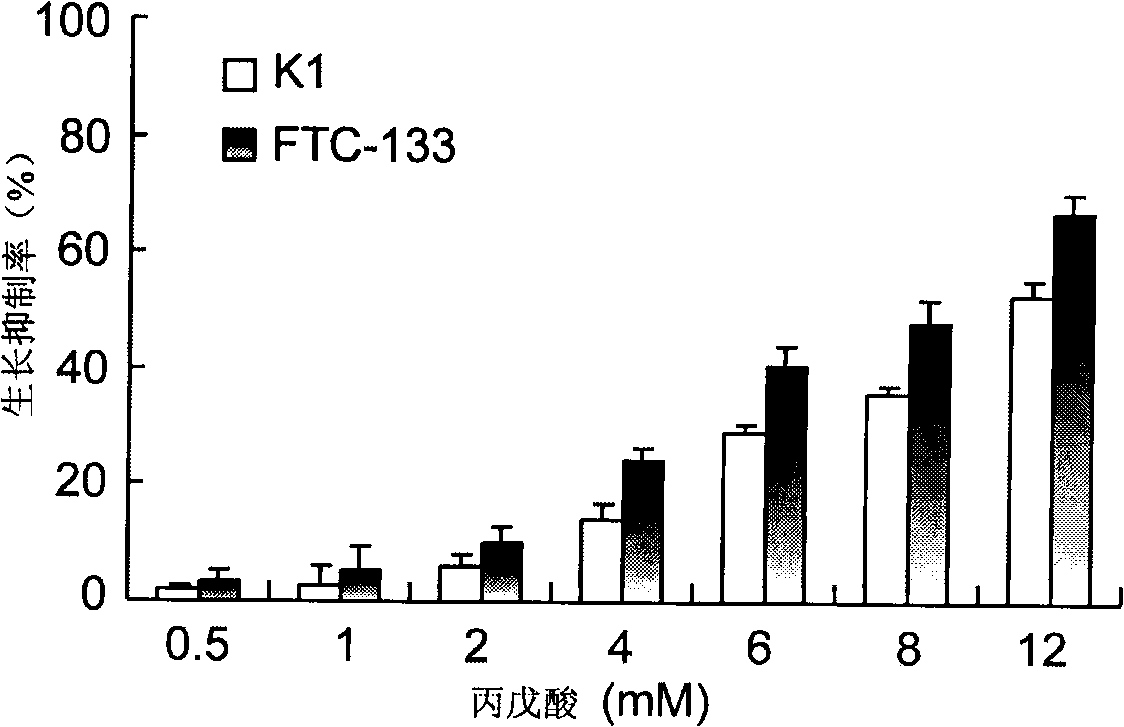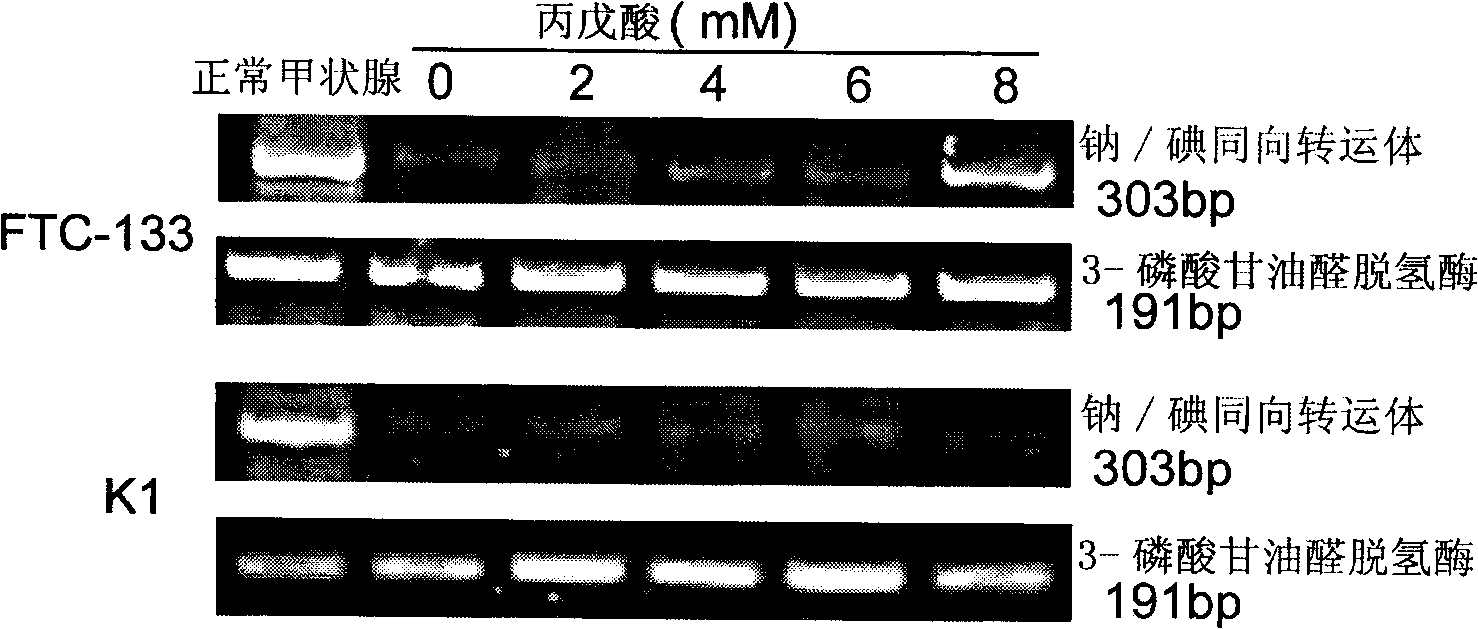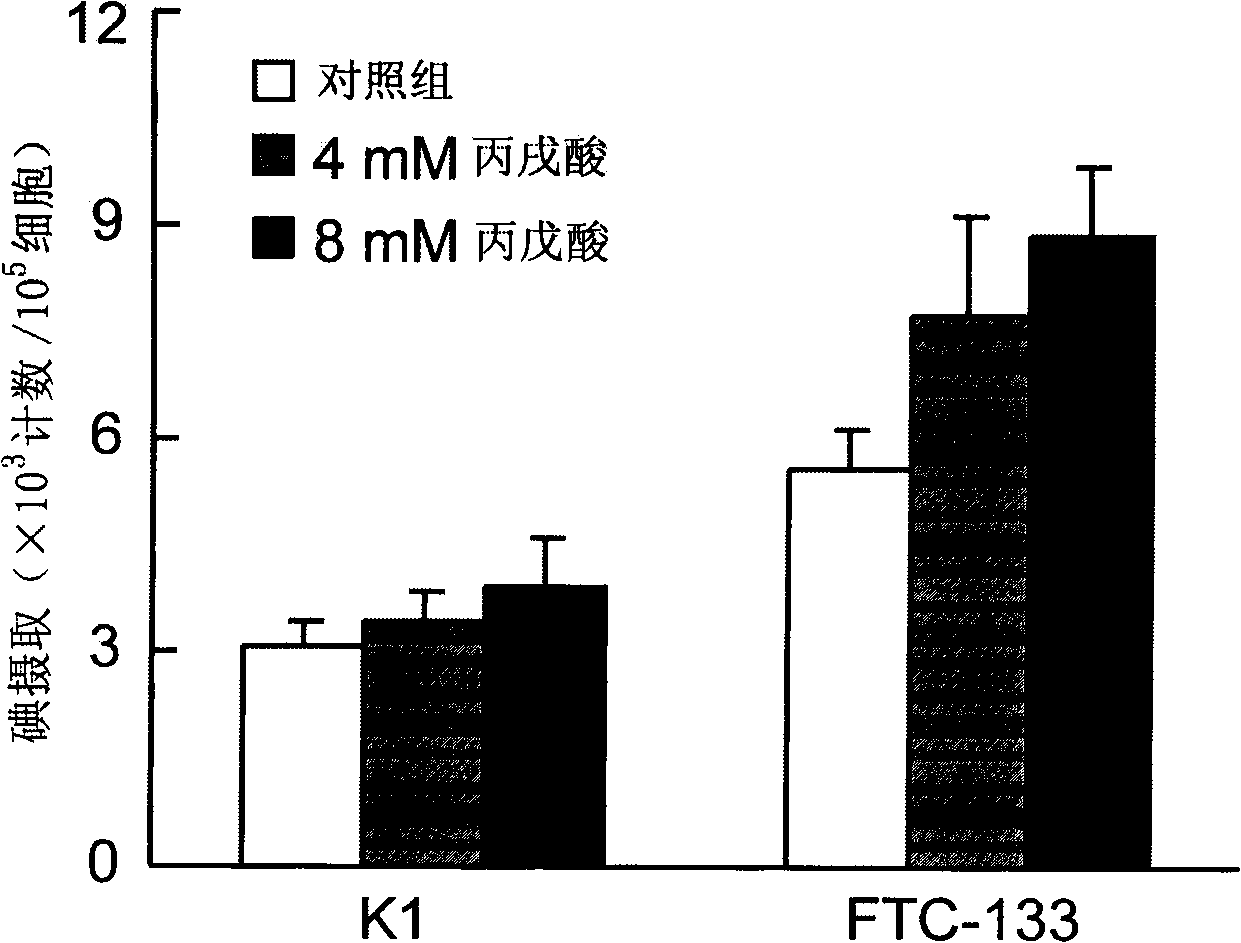Application of valproate and salt-induced redifferentiation combined with <131> iodine thereof in treating poor differentiation/dedifferentiation thyroid cancer
A technology of thyroid cancer and valproic acid, which is applied in the direction of active ingredients of anhydride/acid/halide, drug combination, biochemical equipment and methods, etc. It can solve problems such as inability to apply radioactive iodine therapy, lower iodine intake, and no iodine intake
- Summary
- Abstract
- Description
- Claims
- Application Information
AI Technical Summary
Problems solved by technology
Method used
Image
Examples
Embodiment 1
[0016] Valproic acid inhibits the proliferation of thyroid cancer cells: Take well-grown cultured cells and dilute 1×10 4 Cells / well were seeded in 96-well cell culture plates, with four parallel wells in each group. After the cells adhered to the wall, different concentrations of valproic acid (0.5, 1, 2, 4, 6, 8 and 12 mmol / L) were added, and no drug was added to the control group. After culturing for 48 hours, the culture plate was taken out, the culture medium was carefully discarded, and 200 μL / well of 10% trichloroacetic acid (TCA) was slowly added, and left at 4°C for 1 hour. After the fixation, the fixative was discarded, and washed three times with distilled water to remove TCA. After air drying, add 150 μL / well of 0.4% sulforhodamine B staining solution, and stain at 37°C for 30 minutes. Discard the dye solution, wash with 1% acetic acid 3 times to fully remove unbound sulforhodamine B, after air drying, add 10mmol / LTris solution at 100μL / well to dissolve, oscillat...
Embodiment 2
[0020] Valproic acid induced the increase of NIS mRNA expression in FTC-133 and K1 cells: Cells in the logarithmic growth phase were seeded in 6-well cell culture plates (5×10 5 / well), cultivated overnight, added different final concentrations of VPA (0, 2, 4, 6 and 8mmol / L), continued to cultivate for 48h, and collected the cells. Total cellular RNA was extracted with Tri-Reagent. cDNA was synthesized by reverse transcription, the transcription level of NIS was detected by PCR, and GAPDH was used as internal reference. The reverse transcription reaction system was 25 μL, and the reaction conditions were: 42° C. for 1 h. The PCR system is 20 μL, the reaction conditions of NIS: 94°C pre-denaturation for 5 minutes, 94°C denaturation for 20s, 64°C annealing for 30s, 72°C extension for 60s, a total of 40 cycles, and finally 72°C extension for 7min; GAPDH PCR reaction conditions: 94°C Pre-denaturation for 5 minutes, denaturation at 94°C for 20s, annealing at 60°C for 30s, extens...
Embodiment 3
[0023] Valproic acid induces thyroid cancer cells to increase the uptake of radioactive iodine: take logarithmic growth FTC-133 and K1 cells, add 4mmol / L and 8mmol / L valproic acid for 48h, digest and count, and use serum-free The medium was adjusted to a cell concentration of 2.5×10 6 cells / mL, add 74kBqNa per milliliter of cell suspension 125 I and 10 μM NaI, mix well and incubate in a 37°C water bath for 1 h, take 200 μl of cell suspension from each tube, centrifuge at 5000 rpm for 5 min, discard the supernatant, wash the cells twice with 4°C pre-cooled saline, and measure each cell suspension with a γ-counter Radioactive counts (cpm) of the tube cell pellet. All manipulations were done in quadruple tubes.
[0024] The iodine uptake of FTC-133 cells was significantly increased after being induced by valproic acid, and it was positively correlated with the drug concentration. P0.05; t=0.272, P>0.05) (see image 3 ).
PUM
 Login to View More
Login to View More Abstract
Description
Claims
Application Information
 Login to View More
Login to View More - R&D
- Intellectual Property
- Life Sciences
- Materials
- Tech Scout
- Unparalleled Data Quality
- Higher Quality Content
- 60% Fewer Hallucinations
Browse by: Latest US Patents, China's latest patents, Technical Efficacy Thesaurus, Application Domain, Technology Topic, Popular Technical Reports.
© 2025 PatSnap. All rights reserved.Legal|Privacy policy|Modern Slavery Act Transparency Statement|Sitemap|About US| Contact US: help@patsnap.com



